
BANDA DE LOS MUERTOS (Barbès Records BR0040)
The BBC has done stories lately about the Robin Hood-type figure, Jesus Malverde, who has become the narco-saint of the drug cartels of Sinaloa. The neighborhoods where El Chapo grew up are now booming thanks to the marijuana and opium trade and so, we imagine, are the local brass bands. Which brings us somehow to Brooklyn. Here are a couple of highly sophisticated jazz musicians, Oscar Noriega, a saxophonist and clarinetist who has worked with Paul Motian among others, and 'bone-player Jacob Garchik who has written charts for Kronos Quartet. Noriega comes from a musical family and has been in bands all his life, playing rancheros, boleros and cumbias which were part of his parents' generation's music. The thing that unites these guys is a love for Sinaloense brass band music, so they've created their own hybrid, with the ghosts of Diz and Machito smiling in the wings as they romp through tunes new and old. It's massive fun and also has some great solos thrown in as you would expect. Mireya Ramos sings on a couple of numbers. They kick off with a self-penned cumbia with frilly clarinets over a beefy sousaphone, pumped up by Garchik, then perform a tune written by Noriega's abuela "Te quiero tanto," in this romping rumbustious set. There's a nice take on Julio Jaramillo's evergreen "Ay Mexicanita," and a (genuinely) emotional (not cornball) reading of "Tu recuerdo y yo," which was featured in a 1953 Pedro Infante film, Anxiety. They even cover Marty Robbins' "El Paso," as well as a hit by Cruz Lizarraga. They can ham it up when needed. "Tragos amargos" reminds me of the drunken trombone you hear in Looney Tunes' scores by Carl Stalling or Milt Franklyn and I mean that as a compliment, there's a real visual quality to their playing, as well as finely honed chops.
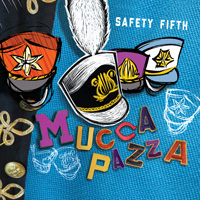
MUCCA PAZZA
SAFETY FIFTH (Electric Cowbell ECR703)
This ensemble is a Midwestern marching band, which means they are big on drums and beats, have the odd triangle or glockenspiel note, and massed horns. More than that, they having cool arrangements, bringing in slide guitar, & other guest sounds that give great variety to the set. At times they remind me of Ennio Morricone and at other times of Carl Stalling which is high praise from me. While predominantly a marching band they have a "freak section" which includes mandolin, accordion, violin and the aforementioned guitarist to add variety. Apparently in concert they have head-mounted amplifiers (for the freaks, not normally audible while walking and playing) and cheerleaders who yell surrealistic algebraic formulae. They key here is tightness and they have the chops to start and stop on a dime and not let the massed brass get away from them. It's half circus act and half punk band masquerading as a marching band. It would be great to see them in a parade, and they will be touring the US in summer 2012.
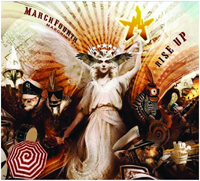
MARCH FOURTH MARCHING BAND
RISE UP (M4 records 37885 55762)
New Orleans style brass band music with a twist. Founded in Portland, Oregon in 2003 the band is a circus-like spectacle with stilt-walkers, puppeteers, fire-eaters & clowns and the music a lively mix of traditional New Orleans with Fela, Fleetwood Mac, and other Looney Tunes -- in short all the staples of a hip high school band. It's all brass and drums with the addition of electric bass. There's 13 brass instruments and 11 percussion, so it's a big sound, but the disc is clear as a bell so you hear baritone sax or trumpet soloing against the tight sheen of sound. The compositions are mostly original, with the old standby Raymond Scott's "Powerhouse," and a cover of "Simplon cocek," a traditional Balkan piece that was the lead track on Zlatne Uste Balkan Brass Band's Rounder CD "No Strings Attached." Nino Rota looms large in "Contada Ridiculata" which quotes some familiar Fellini-esque motifs. "Nightmarika" riffs off Leonard Bernstein's "America" attaining a nightmarish grandeur. "Freestyle for Miles" is a pastiche of some Miles grooves with sharp soloing.
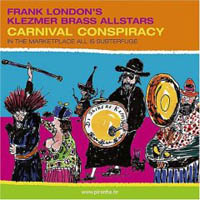
FRANK LONDON'S KLEZMER BRASS ALLSTARS
CARNIVAL CONSPIRACY (Piranha CD PIR1902)
You've heard of "the wandering Jew," well, the first Jews in North America came by boat from Brazil 350 years ago. Frank London's latest release is a compilation of carnivalesque songs from around the world, commemorating this anniversary. I have listened to this several times, trying to get a handle on it. Sometimes I think it's circus music, othertimes the soundtrack for a very sad black & white film about Lodz. It's Klezmer which means I keep ad libbing "If I were a rich man" or "You've gotta pick a pocket or two" to certain familiar musical motifs that pop up. Mostly it's traditional stuff (which doesn't really engage me), but the eighth track "A Time of desire," makes this a keeper (until they do ELECTRIC GYPSYLAND II where it belongs). It's a wild dubby experimental remix of a traditional tune with Kol Isha on the knobs. After that the last four tracks seem coherent and diverse enough to be interesting, so it's one of those albums that doesn't really start at the beginning. The tunes are all traditional but London's arrangements are excellent. I always regret studying German in secondary school instead of Spanish, but I have picked up Spanish by osmosis, and the German comes in handy when trying to decipher Yiddish. "Pantagruel, shikker hindert prozent," is a song title referring to the shit-faced comic character in Rabelais' novel. Drunkenness is evoked in the rollicking tuba bass and slurred trumpet lines. The liner notes, by London, clearly derive from a reading of Mikhail Bakhtin's brilliant opus on the language of the marketplace in Rabelais. KLEZMER CONSPIRACY is enjoyable if you put it on random sequence and have a drink or two and fart and belch periodically to punctuate the music.
To get political for just a moment, I have to agree with Mr McDinnerjazz, president of Iran, that Israel should be moved to the USA. No one cares about New Jersey, it's a dump. So let's rename it New Jerusalem and give it to the Israelis. We can clean it up with the millions we spend on military aid and disarm them at the same time. Plus they'll all be near their bubbes in the Bronx and can shop at Zabar's. The dispossessed Palestinians can have their land back & Bushco can concentrate on more important problems, like destabilizing Latin America. (End of rant in the spirit of Rabelais.)

BANDA CITTÁ RUVO DI PUGLIA
LA BANDA (Enja 9326 22)
My passion for brass band music was stirred by an Italian release in 1996 called simply La Banda. This banda were Italian students at the Conservatory of Music in Bari who had the great film-composer Nino Rota as their teacher. Traditional Italian opera arias were best known in the era before phonographs via brass ensembles who would go through the country as strolling buskers, or be located in small municipalities. But other than Easter Week processions, the traditional Italian banda had died out. La Banda Cittá Ruvo di Puglia are a recreation of this type of ensemble and their album is a lovingly rendered collection of Bizet, Puccini and Verdi hits, including the sublime "Nessun dorma." A second live disc in the album shows them with their hair down, accompanying visiting firemen like Willem Breuker, as they play longer contemporary compositions. Lucilla Galeazzi sings "Una Serenata" in a virtuoso display with only a tuba accompaniment, played by Michel Godard, and then she does the tuba sostenuo part while the tubist goes wild. The album ends with a long symphonic adaptation of Rota's "Sacra Romana Rota."
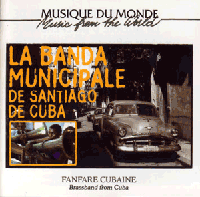
LA BANDA MUNICIPALE DE SANTIAGO DE CUBA
FANFARE CUBAIN (Musique du Monde 92724-2)
From the classical rather than folkloric end of the musical spectrum comes another sublime Cuban album, this one of street brass band music.
La Banda Municipale de Santiago de Cuba's FANFARE CUBAIN is the next best thing to Sunday afternoon in the town square in the old town of Santiago. We even get a brief introduction of ambient sound: birds, distant traffic, kids playing. Then the 40-piece bands swells into life and transports us into the aether. The band was formed in 1898, and after working on their chops for a hundred years, this is their first recording!
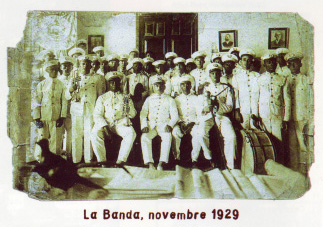
After their moody and impressionistic version of Ernesto Lecuona's "La Comparsa" we get the stately danzon "Reina Isabel," but a trumpet solo at the end tears it up and things start to rock. The old chestnut "El Manisero" is given a rollicking arrangement, while a less-well-known son, "Frutas de Caney," has humorous off-beat percussion that makes you think of a dancing pantomime horse. By the start of "Chan Chan" we think we are ready for anything, but the bass riff on tuba is mind-blowing. Again loping percussion drives the polished machine and this time a soaring clarinet rides over the sustained chorus. The whole things is reined in a just over three minutes. It's breath-taking. In fact all the selections are very tight and cover the whole lexicon of Cuban musical styles, from pop to classical. Some of the less familiar operatic pieces, like the late-nineteenth-century habanera "La Petite Cantante," are so infectious you find youself whistling the melody unconsciously. It's a form that was also employed by Ravel, Bizet, Debussy and others, and this piece has the same romantic feeling.
Despite the largeness of the band, the horn colours are well-modulated and the percussion is omnipresent which keeps things lively (there are two timbales, tumbador, bongo, guiro and clave). This is a happy, infectious album with some superb arrangements that sound more expansive than you would expect from a brass band. The soloists are very jazzy and compare favorably to say Ellington's or Lester Bowie's frontline.La Banda Municipale is one for the ages.
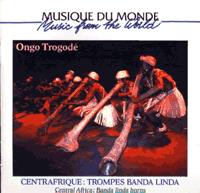
CENTRAFRIQUE: TROMPES BANDA LINDA
ONGO TROGODÉ (Musique du Monde)
ONGO TROGODÉ is another fine folkloric release on the Musique du Monde label from France. The Banda are the main ethnic group in the Central African Republic and are farmers in the savannah region in the Northeast of the country. Their horns are readymade tree roots, hollowed out by termites, and are similar to the didjeridoo of the Australian aborigines. Each horn emits a single note and twenty are grouped together forming four pentatonic scales. For higher notes, antelope horns with lateral mouthpieces are used. If you are familiar with the cyclical machine-like tape loops of Steve Reich, this is a source for that. In fact Western composers since the Middle Ages have used polyphonic layering for effect. Before Reich, Anton Webern and Duke Ellington also investigated the technique.
The musicians of the Trogodé village are considered the best and were chosen for this recording. Each musician has his own tempo so the theme slides and evolves. It is very trancelike and meditative, though the music seems to be propelled by a polyphony of hiccups. The repertoire includes music for rituals (harvest cycles, weddings, circumcisions, the arrival of foreign visitors). For variety the group also play slit log drums, xylophones, and zithers. Because of their isolation, these musicians have preserved a rich heritage unaffected by Western influences, yet strangely familiar to those versed in musical structures.
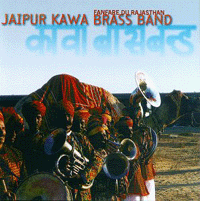
JAIPUR KAWA BRASS BAND
FANFARE DU RAJASTHAN (Kardum/Iris Musique KAR077 1997)
It just occured to me that in the sixties Ravi Shankar broke into our musical consciousness, so Indian music was probably the first non-Western music to make an impact in our time. I remember vividly his soundtrack to the classic Satyajit Ray movie PATHER PANCHALI: the slow meditative quality of the ragas matched the eloquent calligraphic beauty of the cinematography. (In the sixties everyone, as I recall, listened to ragas all the time.) But there is another musical surprise in that classic film: halfway through there is a carnival where a brass band performs. It's some broken-down version of a Western military match ("It's a Long Way to Tipperary" indeed!) that has completely gone AWOL. Clarinets and tubas romp with audacity across the metre.
In my passion for brass band music (following last year's LA BANDA from Italy and this year's LA BANDA MUNICIPALE DE SANTIAGO, CUBA), I picked up on FANFARE DU RAJASTHAN by the Jaipur Kawa Brass Band. The British brought brass instruments to India in the eighteenth century and the native population grew to love these alien instruments: clarinets, trumpets, trombones, sousaphones and tubas. Bright red turbans and handlebar moustaches are regulation dress for these chaps. But their musical chops are pure snake-charmer magic.
Today, brass bands are to India what mariachis are to California, Texas and New Mexico. There are dozens of them in every big city, and they are a fixture at weddings, baptisms, religious pilgrimages and parties (their popularity is partly due to aural dynamics: they are capable of silencing the loudest party guests and drowning out traffic noises too!). But their repertoire nowadays consists of "filmi" soundtrack favorites as much as folk songs, and only stray quotes from the military repertoire.
Hameed Khan, also leader and tabla player for Musafir, is the musical director and arranger for the Jaipur Kawa Brass Band. He has hand-picked the best musicians for improvisation and harmonizing skills. The result is a fiery, even explosive addition to the brass canon.